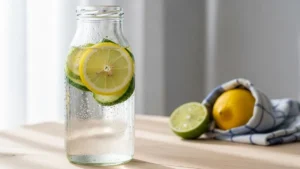
Quick Answers to What People Ask
Can I make alkaline water at home easily?
Yes, you can make alkaline water at home using basic kitchen ingredients. You only need filtered water, baking soda, or lemon. Each option raises the pH level slightly, creating mild alkalinity. No fancy gadgets, no hidden tricks just household items that cost pennies. If you’ve got a jug and a spoon, you’re already halfway there. The simplest method is adding ⅛ teaspoon of baking soda to one liter of clean water. Shake or stir it well until dissolved. Test with pH strips if you want to be sure you’re aiming for a pH of 8 to 9.
Is homemade alkaline water safe to drink every day?
Yes, it’s generally safe for healthy adults when made properly. The key is moderation drink it like normal water, not medicine. Alkaline water with a pH of 8 or 9 is mild enough for daily use. Going above that can cause stomach discomfort. People with kidney issues, heart conditions, or on medications should check with a doctor first. For most others, 1–2 glasses a day are fine. It’s water just a bit smoother on the stomach.
Do I need special tools or machines?
No, you don’t need any machine to make alkaline water. Simple tools like a jug, spoon, and pH test strips do the job. Machines like ionizers exist, but they’re optional. They speed up the process but don’t make the water “better.” For a budget-friendly setup, stick to baking soda, lemon, or mineral drops. They’re safe, cheap, and proven. Testing your water with pH strips is the only “extra” step worth taking if you want accuracy.
How much does it really cost to make it?
Making alkaline water at home costs almost nothing. A box of baking soda costs less than a cup of coffee and lasts for months. Lemons are cheap and easy to find. Even pH drops cost less than a single bottle of store-bought alkaline water. On average, homemade alkaline water costs around $0.02–$0.05 per liter, while store-bought versions can reach $2–$4. The difference is massive. You’re saving money while controlling exactly what’s in your water.
What Alkaline Water Actually Means
The simple science behind pH and alkalinity
pH measures how acidic or basic water is on a scale of 0 to 14. Anything below 7 is acidic, 7 is neutral, and above 7 is alkaline. So, when we talk about alkaline water, we mean water that has a pH higher than 7. Alkalinity comes from minerals like calcium, potassium, and magnesium that balance acid in the body. These minerals naturally exist in some spring waters, while homemade alkaline water uses ingredients like baking soda or lemon to achieve similar results. In short, the “alkaline” label isn’t magic it’s chemistry. It’s about balancing acidity to create smoother, less harsh water.
How alkaline water differs from regular tap water
Regular tap water usually has a neutral pH of 7, while alkaline water ranges between 8 and 9. The higher pH gives it a smoother, less tangy taste. It may also contain extra minerals that your tap water lacks, depending on your area. The key difference isn’t taste alone it’s composition. Tap water can carry traces of chlorine or heavy metals, while alkaline water often has cleaner mineral content, especially if you use filtered water first. The change in taste and texture is subtle but noticeable once you compare both. If you’ve ever tasted mountain spring water, that crisp, clean feel is what mild alkalinity mimics.
Why some people prefer alkaline water
Many people prefer alkaline water because it feels smoother, tastes cleaner, and may ease acid-related discomfort. Some say it helps with digestion or acid reflux, while others just enjoy the softer texture compared to plain tap water. Health experts remain cautious, but mild alkalinity can make a difference for people sensitive to acidic drinks. It’s not a cure or supplement it’s a small lifestyle tweak that can make drinking water more enjoyable.
Benefits People Associate with Alkaline Water
Helps reduce acid levels in the body
Alkaline water may help neutralize acid in the body by slightly increasing the pH level of your blood and stomach. This can create a more balanced internal environment for those who struggle with acid reflux or heartburn. The science behind this is simple. Acidic foods like coffee, soda, and processed meals can drop your internal pH, making your stomach feel unsettled. Drinking mildly alkaline water, with a pH between 8 and 9, can help neutralize that acidity. It’s not a medicine, but it’s a practical way to ease occasional acid discomfort. For those who often rely on antacids, it can serve as a gentler daily option.
May improve hydration
Alkaline water may hydrate the body slightly better than plain tap water due to its higher mineral content and smaller molecular clusters. That means your body can absorb it faster and more efficiently, especially after sweating or workouts. Several studies suggest that the presence of electrolytes such as calcium, potassium, and magnesium in alkaline water supports better fluid balance. For people who don’t enjoy plain water, its smooth taste can encourage them to drink more regularly, which is the real hydration benefit. Hydration isn’t just about drinking more; it’s about how well your body uses what you drink. Mild alkalinity helps that process along.
Might support better digestion and energy
Drinking alkaline water might help digestion by reducing acid buildup and improving how the stomach breaks down food. When your stomach isn’t overloaded with acid, digestion runs smoother and you feel lighter after meals. This, in turn, can leave you with more consistent energy. People who switch to alkaline water often report less bloating and sluggishness, especially after acidic or heavy meals. While scientific proof is still limited, user feedback points to mild digestive comfort as a real benefit. It’s not a miracle fix, but think of it like tuning your system smoother digestion means steadier energy throughout the day.
Different Ways to Make Alkaline Water at Home
Method 1: Use Baking Soda
To make alkaline water with baking soda, mix ⅛ teaspoon of baking soda in one liter of filtered water. Stir or shake until it’s fully dissolved. This raises the pH of water from neutral (7) to around 8.5 or 9, making it safely alkaline. Always use clean, food-grade baking soda never baking powder. Too much baking soda can make your water taste salty and upset your stomach. Stick to small amounts, especially if you drink it daily. If you’re unsure, use pH strips to check your mix. Light green means neutral; blue-green to blue means alkaline. That’s how you know you’ve got it right.
Method 2: Add Lemon or Lime
Even though lemons and limes taste acidic, they turn alkaline once digested. When mixed with water, the citric acid interacts with your body’s chemistry, creating an alkaline effect in the bloodstream. To make it, squeeze half a lemon or lime into one liter of filtered water. Let it sit for 5 to 10 minutes before drinking. You can also add lemon slices to a pitcher and keep it in the fridge for regular use. This method doesn’t raise the water’s pH drastically, but it’s natural, refreshing, and easy on the stomach. It’s also loaded with vitamin C, which supports immunity and hydration.
Method 3: Use pH Drops
pH drops are a simple way to make alkaline water instantly. Just add 2 to 3 drops to one glass (about 250 ml) of water, then test with a pH strip if you want confirmation. These drops contain safe minerals like potassium, calcium, and magnesium that quickly raise pH without affecting taste. They’re small, portable, and ideal if you travel often or want consistent results without measuring. To test your water, dip a pH strip for two seconds and compare the color. A green-to-blue shift means your water is now mildly alkaline.
Method 4: Use Water Filter Pitchers or Ionizers
Water filter pitchers and ionizers make alkaline water automatically by adding minerals and filtering out impurities. They work by passing water through special cartridges that boost its pH to between 8 and 9.5. Pitchers are affordable, costing between $25 and $60, while electric ionizers can range from $150 to $1000. The main advantage is consistency you don’t have to measure or mix anything. Just fill, wait a few minutes, and pour. Maintenance is simple. Replace filters every two to three months and clean the unit with mild vinegar water. You’ll get cleaner, smoother water without effort.
How to Test the pH of Your Water
Using pH strips at home
You can check your water’s pH easily with pH strips. Dip the strip into a glass of water for a few seconds, then compare the color to the chart that comes with it. Green means neutral (7), blue-green to blue means mildly alkaline (8–9). This method is cheap, quick, and safe. It’s ideal for checking homemade alkaline water after adding baking soda, lemon, or pH drops. Make sure your hands are dry, and don’t touch the test area to avoid inaccurate results.
Digital pH meters for accuracy
Digital pH meters give more precise readings than strips. Simply calibrate the device, dip the probe into water, and read the value on the screen. It’s fast, accurate, and ideal if you make alkaline water regularly. Digital meters are a bit more expensive ($15–$40) but last a long time. They remove guesswork and help ensure your water stays within the safe pH range. Rechargeable or battery-powered models are convenient for home use.
What pH level is safe for drinking water
Safe drinking water has a pH between 7 and 9. Mildly alkaline water, with a pH of 8–9, is ideal for most adults. Water with a pH higher than 10 or lower than 6 can cause stomach discomfort or taste issues. The goal isn’t extreme alkalinity it’s moderate, drinkable water. Most homemade methods, like baking soda or lemon water, naturally stay in this safe range. Regular testing ensures your water is healthy and pleasant to drink.
|
pH Level |
Water Type |
Safe to Drink? |
| 6–7 | Neutral |
Yes |
| 8–9 | Mildly Alkaline |
Yes |
| 10+ | Strong Alkaline |
No |
Common Mistakes to Avoid
Adding too much baking soda
Too much baking soda can make your water taste salty and upset your stomach. Stick to ⅛ teaspoon per liter of water. Overdoing it doesn’t make your water healthier it just increases risk of digestive discomfort. A small, measured amount is enough to raise pH safely. Always stir well and test with pH strips if you want confirmation.
Believing higher pH means healthier
A higher pH doesn’t automatically make water better for you. Extremely alkaline water (pH 10+) can irritate your stomach and taste unpleasant. Mild alkalinity, around 8–9, is enough for hydration and comfort. Focus on safe, drinkable water rather than chasing extreme numbers. The goal is balance, not excess.
Ignoring water quality before alkalizing
Alkaline water is only as good as the water you start with. Using tap water with contaminants can reduce its safety. Always filter your water first to remove chlorine, heavy metals, or sediments. Filtered water ensures your homemade alkaline water is clean, tastes better, and is safe for daily use. Don’t skip this step it’s the foundation of every method.
Safety Tips for Making Alkaline Water at Home
Use clean, filtered water as your base
Always start with filtered or purified water. Tap water can contain chlorine, heavy metals, or sediments that affect taste and safety. Filtering ensures your alkaline water is clean and safe to drink daily. A simple carbon filter pitcher works well. For extra caution, boil water first or use a reverse-osmosis system. Clean water is the foundation of safe alkaline water.
Follow measured quantities only
Stick to recommended amounts of baking soda, lemon, or pH drops. Overdoing it can cause digestive discomfort, high sodium intake, or overly strong taste. Small, precise measurements are enough to achieve mild alkalinity. Use a teaspoon or digital scale to measure baking soda accurately. Test the water with pH strips to make sure it stays in the safe range of 8–9.
Check with your doctor if you have health conditions
If you have kidney issues, heart conditions, or are on medication, consult your doctor first. Alkaline water is mild, but high pH or added minerals may affect certain medical conditions. For healthy adults, 1–2 glasses a day is generally safe. When in doubt, a short consultation avoids potential complications.
Cost Comparison: Homemade vs Store-Bought Alkaline Water
Average cost per liter at home
Making alkaline water at home costs just a few cents per liter. A box of baking soda or a few lemons can last for months. Using filtered water and simple ingredients, you spend around $0.02–$0.05 per liter. Even adding pH drops raises the cost only slightly, around $0.10 per liter. That’s far cheaper than any store-bought option.
Average cost per liter of bottled alkaline water
Bottled alkaline water costs significantly more. On average, a liter costs $2–$4 depending on the brand and location. High-end brands or imported waters can go even higher. This adds up fast if you drink multiple liters per day. Over a month, buying bottled water can cost $60–$120, whereas making it at home may cost under $2.
Why homemade options save more over time
Homemade alkaline water is a clear winner for long-term savings. Once you buy the initial supplies, you can make dozens of liters for almost no cost. The ingredients are reusable, shelf-stable, and easy to find. You also control the quality, taste, and mineral content. The more water you drink, the more money you save. Over a year, the difference can be hundreds of dollars all while keeping your water safe and fresh.
How to Store Alkaline Water Properly
Best containers to use (glass vs plastic)
Glass containers are the best choice for storing alkaline water. They don’t leach chemicals or affect taste. Plastic bottles are okay for short-term use but may slowly change the water’s flavor and pH. Mason jars, glass pitchers, or stainless steel bottles with tight lids work perfectly. Keep containers clean to avoid bacterial growth.
How long alkaline water stays effective
Alkaline water is most effective when consumed within 24–48 hours of preparation. Over time, it can slowly lose its pH and minerals, especially if exposed to air or sunlight. Refrigerate your water to preserve alkalinity and freshness. Small batches are better than making large amounts that sit for days.
Signs your water’s pH is dropping
If your alkaline water tastes flat, slightly sour, or metallic, its pH may be dropping. Testing with pH strips can confirm the change. Other signs include cloudiness or a dull appearance. Always check water before drinking if it’s been stored for more than a day. Fresh, properly stored water ensures you get the full benefits.
Final Thought
Making alkaline water at home doesn’t have to be complicated or expensive. Simple methods like adding baking soda, squeezing lemon, or using pH drops give you safe, mildly alkaline water. Filtered water is your base, and careful measurements keep it healthy and pleasant. Drink it in moderation. One to two glasses a day is enough to enjoy the mild benefits. Extremely high pH water isn’t necessary and may cause digestive discomfort. Test your water regularly. pH strips or digital meters help ensure your water stays between 8 and 9. Proper storage in glass or stainless steel containers preserves freshness and alkalinity.
FAQs
Can kids drink alkaline water?
Yes, but in moderation. Mildly alkaline water (pH 8–9) is generally safe for children, but they don’t need large amounts. Stick to one small glass per day and ensure the base water is clean and filtered. Kids’ digestive systems are sensitive. Overly alkaline water or high mineral content may upset their stomach. Keep it occasional and balanced with regular tap or filtered water.
Is bottled alkaline water better?
Not necessarily. Bottled alkaline water can be convenient, but it’s far more expensive than homemade options. Its pH may be slightly higher, but taste and minerals vary by brand. Making your own allows control over taste, minerals, and pH. Plus, it’s sustainable and cheaper. Store-bought water is useful for travel or occasional use.
How often should I drink alkaline water?
1–2 glasses per day is enough for most adults. Daily hydration is important, but extreme consumption isn’t necessary. Mild alkalinity is more than sufficient for taste and comfort. Spread intake throughout the day, preferably with meals or after light exercise. Overconsumption can cause stomach upset or interfere with natural stomach acidity.
Can I use Himalayan salt to make it?
Yes, a tiny pinch can help add minerals and mild alkalinity. Dissolve 1/16 teaspoon per liter of water. Himalayan salt contains trace minerals like potassium and magnesium, which slightly raise pH. Use it sparingly. Too much salt can increase sodium intake and alter taste. It’s best combined with filtered water for daily consumption.
Does boiling water make it alkaline?
Boiling alone doesn’t make water alkaline. It removes some dissolved gases but doesn’t increase pH significantly. You’ll need baking soda, pH drops, or minerals to actually raise alkalinity. Boiled water can be a good base, though, because it’s cleaner and safer. Add your chosen alkalizing method after cooling the water.







